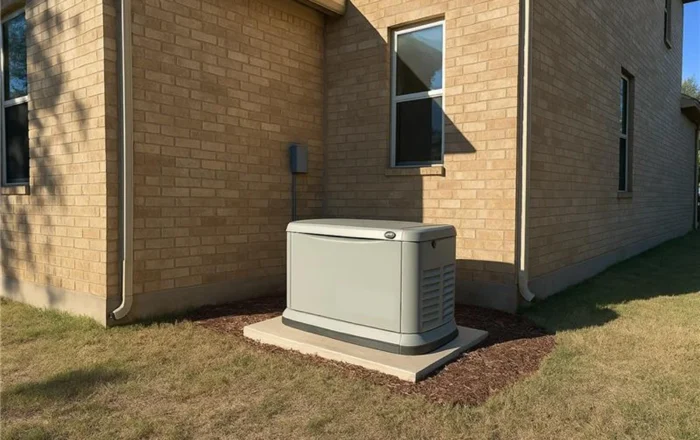How to Choose a Generator for Your Home
6 minute readHow to choose the right generator for your Texas home
Home > Blog > Tesla Powerwall: Is It Right For Your Home?
4 minute read • Last update March 2024

Texas ranks first in the nation for power outages. Some last just a few minutes, whereas other disruptions last several hours or more. That’s why many Texans rely on a backup power supply during frequent power outages.
Among the myriad options for ensuring continuous power output while the grid is down, the Tesla Powerwall stands out as a modern and innovative solution. But precisely what is Tesla Powerwall, and how does it work?
In this quick guide, we’ll cover everything you need to know, including price, installation information, and the key features and benefits of a Tesla Powerwall.
The Tesla Powerwall is a rechargeable lithium ion battery that provides energy storage for residential solar panel systems. The built-in solar inverter stores excess energy to supply homes with more power during peak hours when grid demand is high, and sunlight is unavailable, like at night and during cloudy weather. The stored energy can also be used for backup power in case of electrical grid outages.
So, how does it work? The Tesla Powerwall battery is equipped with intelligent monitoring and control systems that automatically switch when the power goes down, routing stored energy to appliances and devices when grid outages occur.
The total Tesla Powerwall price depends on which model you choose and how many you purchase. All Powerwall models have a storage capacity of 13.5 kWh. However, there is some variance between weight, power output, and scalability. The right option for you will depend on the specifics of your current/planned solar system. Here’s a quick overview:
Calculating exactly how much a Tesla Powerwall costs is complicated because solar battery prices vary by location. Plus, while the starting price for a single Tesla home battery is typically around $14,700 (including installation fees), the unit price goes down the more you buy.
As with unit price, specific installation costs vary by location and whether you’re purchasing one or multiple batteries. Regardless of whether you buy directly or use a third-party contractor, the cost of Tesla Powerwall installation is typically included, as is the gateway for data transfer and any additional accessories you’ll need for effective operation. However, any modifications or upgrades required to accommodate a Tesla battery, like additional solar panels, electrical upgrades, or extra wiring, will incur additional costs.
One of the primary benefits of a Tesla Powerwall is the minimal operating expense. Powerwall batteries are designed to require very little maintenance. Short of periodic inspections to ensure proper functioning and a few software updates to optimize performance, little action is required. Additionally, these tasks can usually be performed by homeowners without the need to pay for outside contractors or technicians.
While purchase and setup can be pricey, the round trip efficiency of a Tesla home battery backup is approximately 90%, meaning for every 10 kWh of energy a Powerwall stores, you’ll get 9 kWh of usable capacity. So, there is significant potential to use more of your own electricity rather than paying to access energy from the power grid.
Each Tesla solar battery system is equipped with smart energy management software. The goal is not simply to provide energy storage during blackouts but to optimize usage based on factors like time-of-use pricing, energy demand patterns, and weather forecasts to ensure maximum potential savings. Aside from direct utility bill savings, homeowners may also be eligible for federal tax credits on solar roof and Tesla Powerwall installations.
Let’s examine the primary advantages of enhancing the power capacity of your solar panel system with a Tesla Powerwall.
In the face of fluctuating energy prices and supply uncertainties, it’s advantageous to be more self-sufficient for electricity. Using in-home solar inverters to store and utilize extra energy when you need it most allows you to break free from reliance on external energy providers.
Whether due to severe weather, wildlife interference, power grid failures, or maintenance issues, power outages disrupt daily life. The Powerwall seamlessly transitions to backup mode during emergencies, providing peace of mind that essential appliances and devices remain operational.
Traditional energy generation using fossil fuels contributes to air and water pollution, greenhouse gas emissions, and habitat destruction. Utilizing renewable, clean energy from solar battery cycles reduces pollution and mitigates the impact of climate change.
As with all things Tesla, the Powerwall exemplifies smart energy management. Through intelligent algorithms and predictive analytics, it adapts to changing energy demands and even allows for remote monitoring and control, enabling homeowners to manage their systems from anywhere.
The exact duration of backup power during an outage depends on household energy consumption. However, the Tesla Powerwall’s capacity of 13.5 kilowatt-hours (kWh) should be enough to power essentials like Wi-Fi, cell phones, the refrigerator, and some lights for around 24 hours.
To maximize efficiency and continuous power output, homeowners should prioritize essential appliances, minimize energy consumption where possible, and leverage the power of their solar roof to put more energy back into the Powerwall during daylight hours.
Unfortunately, there’s no black-and-white answer because every household’s needs, preferences, and requirements are different. So, some in-depth research is usually necessary to determine whether a Tesla Powerwall battery is a worthwhile investment for your home.
When analyzing the benefits of a Tesla Powerwall, it’s essential to look beyond the upfront cost, as storing excess energy from your solar roof and utilizing it strategically at optimal times can lead to substantial long-term savings. Here are a few essential factors that may affect your decision:
Regardless of how much energy you save with your solar installation and home battery backup, you still need an electricity plan from a trustworthy supplier.
At BKV Energy, we understand that electricity is an essential service, and our focus is on providing Texans with straightforward energy plans with transparent, easy-to-understand contracts.
Ready to start saving? Simply enter your zip code to compare our straightforward electricity plans and find the best deal for your household.
Graham Lumley, Digital Marketing Manager at BKV Energy, leads digital and traditional marketing strategies, focusing on educating Texans about the state's deregulated energy market. With over 8 years of marketing experience, he creates content to help consumers understand and save on their energy bills, bringing a fresh and dynamic approach to the industry.

How to choose the right generator for your Texas home

Energy Saving Tips Home Improvement
Choosing the right energy-efficient door can help Texas homeowners reduce cooling costs and improve home comfort year-round.
Get $50 off your electric bill!
Use code BKVEJOINUS50
Enter your zip code to shop BKV Energy's affordable, fixed-rate Texas electricity plans. Use the promo code for $50 off your electric bill.